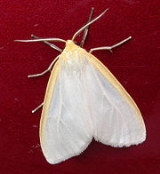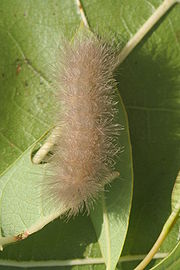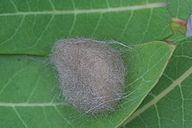
Cycnia tenera
Encyclopedia
Cycnia tenera, the Dogbane tiger-moth or Delicate Cycnia is a moth
in the family Arctiidae
. It occurs throughout North America, from southern British Columbia
to Nova Scotia southwards to Arizona and Florida. Range map: http://www.butterfliesandmoths.org/species?l=3799.
It is a common feeder on Apocynum cannabinum
(dogbane, Indian hemp) which produces a milky latex containing cardenolide
s, toxic cardiac glycoside
that defend against herbivores (Cohen and Brower, 1983). It also feeds on milkweed species, Asclepias, at least in parts of its range, but is most commonly reported from dogbane. Its interactions with bat
s have been much studied, but are an area of dispute regarding whether the clicks emitted by adult moths are disruptive of bat echolocation
, or merely aposematic warning signals. The two functions are not mutually exclusive, however, so that it may not be possible to resolve the issue.

s may be found from June to November (Wagner 2005).
s (Cohen and Brower, 1983). Caterpillars are covered all over in soft grey to whitish hairs. Larvae feed at night.

In a set of experiments using bats that had never been exposed to moths before, Hristov and Conner (2005) found that the clicking signals helped the bats to learn which moths are distasteful, and so to avoid them. They did not rule out a jamming function for the calls, however, and Ratcliffe and Fullard noted that 20% of these native bats aborted attacks on the moth.
The calls are additionally used by male moths to signal to female moths (Conner 1987). Like many Arctiinae
C. tenera flies all day and night, though preferentially some time after dusk. Nonetheless it is certainly not a well-loved prey item of diurnal predators such as insectivorous bird
s either. Its sense of hearing, on the other hand, is only moderately well-developed. Thus, the calls of the Delicate Cycnia have more of a defensive than a social function, and the aposematic role is likely to be significant.(Fullard & Napoleone 2001).
Moth
A moth is an insect closely related to the butterfly, both being of the order Lepidoptera. Moths form the majority of this order; there are thought to be 150,000 to 250,000 different species of moth , with thousands of species yet to be described...
in the family Arctiidae
Arctiidae
Arctiidae is a large and diverse family of moths with around 11,000 species found all over the world, including 6,000 neotropical species. This family includes the groups commonly known as tiger moths , which usually have bright colours, footmen , lichen moths and wasp moths...
. It occurs throughout North America, from southern British Columbia
British Columbia
British Columbia is the westernmost of Canada's provinces and is known for its natural beauty, as reflected in its Latin motto, Splendor sine occasu . Its name was chosen by Queen Victoria in 1858...
to Nova Scotia southwards to Arizona and Florida. Range map: http://www.butterfliesandmoths.org/species?l=3799.
It is a common feeder on Apocynum cannabinum
Apocynum cannabinum
Apocynum cannabinum is a perennial herbaceous plant that grows throughout much of North America - in the southern half of Canada and throughout the United States. It is a poisonous plant: Apocynum means "poisonous to dogs"...
(dogbane, Indian hemp) which produces a milky latex containing cardenolide
Cardenolide
Cardenolide is a type of steroid. Many plants contain derivatives, collectively known as cardenolides, including many in the form of cardenolide glycosides...
s, toxic cardiac glycoside
Cardiac glycoside
Cardiac glycosides are drugs used in the treatment of congestive heart failure and cardiac arrhythmia. These glycosides are found as secondary metabolites in several plants, but also in some animals, such as the milkweed butterflies. -Function:...
that defend against herbivores (Cohen and Brower, 1983). It also feeds on milkweed species, Asclepias, at least in parts of its range, but is most commonly reported from dogbane. Its interactions with bat
Bat
Bats are mammals of the order Chiroptera "hand" and pteron "wing") whose forelimbs form webbed wings, making them the only mammals naturally capable of true and sustained flight. By contrast, other mammals said to fly, such as flying squirrels, gliding possums, and colugos, glide rather than fly,...
s have been much studied, but are an area of dispute regarding whether the clicks emitted by adult moths are disruptive of bat echolocation
Animal echolocation
Echolocation, also called biosonar, is the biological sonar used by several kinds of animals.Echolocating animals emit calls out to the environment and listen to the echoes of those calls that return from various objects near them. They use these echoes to locate and identify the objects...
, or merely aposematic warning signals. The two functions are not mutually exclusive, however, so that it may not be possible to resolve the issue.

Life cycle
This moth has several generations per year through much of its range, so that caterpillarCaterpillar
Caterpillars are the larval form of members of the order Lepidoptera . They are mostly herbivorous in food habit, although some species are insectivorous. Caterpillars are voracious feeders and many of them are considered to be pests in agriculture...
s may be found from June to November (Wagner 2005).
Larvae
Eggs are laid in clutches of 50-100. Larvae are reported to feed in aggregations of 5 to 7, at least in the early instarInstar
An instar is a developmental stage of arthropods, such as insects, between each molt , until sexual maturity is reached. Arthropods must shed the exoskeleton in order to grow or assume a new form. Differences between instars can often be seen in altered body proportions, colors, patterns, or...
s (Cohen and Brower, 1983). Caterpillars are covered all over in soft grey to whitish hairs. Larvae feed at night.

Adults
Wings are white with a buttery yellow margin along the front of the forewing, legs are black. The underside of the forewing may have a dusting of black. The body is yellow with a row of black spots. Wingspan 30-40 mm.Ultrasound calls
Bats refuse to eat either muted or intact moths of C. tenera (Ratcliffe and Fullard, 2005). Hawking bats, that is, those seeking moths in flight, attacked intact, clicking C. tenera less frequently than surgically muted (with tymbal organs destroyed) moths in experiments. Intact moths emitted calls when the hunting bats switched from search phase calls to approach phase calls (Fullard et al., 1994). In gleaning attacks, when bats attack moths perched on surfaces, bats use a different frequency of sound that these moths cannot hear (Fullard 1979), and the moths do not respond until actually handled by bats. Then clicking moths were dropped more frequently than mute moths.In a set of experiments using bats that had never been exposed to moths before, Hristov and Conner (2005) found that the clicking signals helped the bats to learn which moths are distasteful, and so to avoid them. They did not rule out a jamming function for the calls, however, and Ratcliffe and Fullard noted that 20% of these native bats aborted attacks on the moth.
The calls are additionally used by male moths to signal to female moths (Conner 1987). Like many Arctiinae
Arctiinae
The Arctiinae are a subfamily of moths.-Systematics:The systematics of the Arctiinae are in need of revision and depends significantly on a personal view of an author. In any case, Arctiinae is a monophyletic group with a clear autapomorphic character - a presence of anal glands in females. On the...
C. tenera flies all day and night, though preferentially some time after dusk. Nonetheless it is certainly not a well-loved prey item of diurnal predators such as insectivorous bird
Bird
Birds are feathered, winged, bipedal, endothermic , egg-laying, vertebrate animals. Around 10,000 living species and 188 families makes them the most speciose class of tetrapod vertebrates. They inhabit ecosystems across the globe, from the Arctic to the Antarctic. Extant birds range in size from...
s either. Its sense of hearing, on the other hand, is only moderately well-developed. Thus, the calls of the Delicate Cycnia have more of a defensive than a social function, and the aposematic role is likely to be significant.(Fullard & Napoleone 2001).

